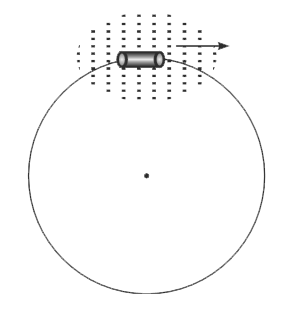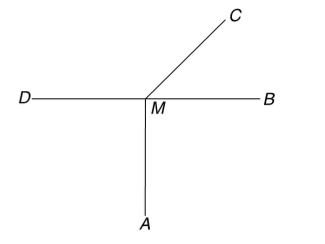A near surface earth satellite has cylindrical shape with cross sectional area ofs=0.5M2 and mass of M = 10 kg. It encounters dust which has density of D=1.6XX10−11KG/ms. Assume that the dust particles are at rest and they stick to the satellite’s front face on collision. Take mean density of earth to beρ=5500kg/m3Find the drag force experienced by the satelliten
 If the dust extends throughout the orbit, find the change in velocity and radius of
the circular path of the satellite in one revolution.
If the dust extends throughout the orbit, find the change in velocity and radius of
the circular path of the satellite in one revolution.
The correct Answer is:(a) 5×10−4N
(b) ΔV=0.25m/s;ΔR=0.4km
Step by step video, text & image solution for A near surface earth satellite has cylindrical shape with cross sectional area ofs=0.5M^(2) and mass of M = 10 kg. It encounters dust which has density of D=1.6XX10^(-11)KG//m^(s). Assume that the dust particles are at rest and they stick to the satellite’s front face on collision. Take mean density of earth to berho=5500kg//m^(3)Find the drag force experienced by the satelliten If the dust extends throughout the orbit, find the change in velocity and radius of the circular path of the satellite in one revolution. by Physics experts to help you in doubts & scoring excellent marks in Class 11 exams.
Updated on:21/07/2023Topper's Solved these Questions
Similar Questions
We know that the atmospheric pressure on the surface of the earth is because of weight, of the air. The radius of the earth is 6400 km and atmospheric pressure on the sruface of earth is 1×105N/m2. Estimate the mass of the earth's atmosphere assuming that acceleration due to gravity remains constant at 10m/s2 over the entrie height of the atmospehre.
View SolutionFour metal rods each of length L and cross sectional area A are joined at point M. Thermal conductivities of MA, MB and MD are equal and that of MC is thrice that of MA. The end points A, B, C and D are kept in large reservoirs. Heat folws into the junction from B at a rate of P(Js−1) and C from at a rate of 3P. Heat flows out of D at a rate of 5P.
(a) Find the relation between temperatures of points A, B and C.
(b) Find temperature of D if temperature of A and M and TA and TM respectively.

View SolutionA cylindrical solid of mass 10^(-2) kg and cross-sectional area 10^(-4) m^(2) is moving parallel to its axis (the x-axis ) with a uniform speed of 10^(3) m//s in the positive direction. At t = 0 , its front face passes the plane x = 0 . The region to the right of htis plane is filled with the dust particle of uniform density 10^(-3) kg/m^(3) . When a dust particles collides with the face of the cylinder, it stricks to its surface. Assuming that the dimensions of the cylinder remain parctically unchanged adn that the dust sticks only to the front face of the cylinder find the x-coordinate of the front of th ecylinder at t = 150 s .
View SolutionIf the period of revolution of an artificial satellite just above the earth be T second and the density of earth be rho , kg//m^(3) then (G = 6.67 xx 10^(-11) m^(3)//kg . "second"^(2) )
View SolutionThe speed fo this dust particle ("mass" =n 10^(-3) g) is measured with the uncertainty of (3.313)/(pi) xx10^(-3) m//s. The minimum uncertainty in position of the dust particle ("in order of"10^(-26) m) is :
View SolutionA satellite revolves round a planet in an orbit just above the surface of planet. Taking G=6.67xx10^(-11) Nm^(2) kg^(-2) and the mean density of the planet =8.0xx10^(3) kg m^(-3) , find the period of satellite.
View SolutionThe radius of the earth is 6.37×106 m and its mean density is 5.5×103kg m−3 and G=6.67×10−11N-m2kg−2 Find the gravitational potential on the surface of the earth.
View Solutionकिसी ग्रह का घनत्व 8×103 किग्रा / मीटर 3 है | कोई उपग्रह इस ग्रह के तल के समीप ही इसके चारो ओर चक्कर काट रहा है | उपग्रह का परिक्रमण - काल ज्ञात कीजिए | (G=6.67×10−11 न्यूटन - मीटर 2 / किग्रा 2 )
View SolutionWhat is the de Broglie wavelength of
A dust particle of mass 1.0×10−9 kg drifting with a speed of 2.2 m/s ?
View Solutionएक बेलनाकार ठोस जिसका द्रव्यमान 10−2 किग्रा तथा परिच्छेद क्षेत्रफल 10−4मी2 है, अपनी अक्ष (x अक्ष) के समान्तर एकसमान चाल 10−4 मी/से से धन दिशा में चल रहा है। t= 0 पर इसका अग्रिम फलक, तल x= 0 से गुजरता है। इस तल के दायीं ओर का क्षेत्र एकसमान घनत्व 10−3 किग्रा/मी−3 के स्थिर घुल के कणों से भरा है। जब कोई धूल का कण बेलन के फलक से टकराता है तो वह इसकी सतह पर चिपक जाता है। यह मानकर कि बेलन का विस्तार व्यवहारिक (Practicaly) दृष्टि से अपरिवर्तित रहता है तथा धूल बेलन के केवल अग्रिम फलक पर ही चिपकती है, बेलन के अग्र भाग का x-निर्देशाक t=150 सेकण्ड पर ज्ञात कीजिये|
View Solutionপৃথিবীর গড় ঘনত্ব 5500kg/m3 মহাকর্ষীয় ধ্রুবক 6.7×10−(11)N⋅m/kg2 এবং পৃথিবীর ব্যাসার্ধ 6400km ধরলে পৃথিবীপৃষ্ঠে অভিকর্ষজ ত্বরণের মান নির্ণয় করো।
View SolutionA bird of mass 1.23 kg is able to hover by imparting a downward velocity 10 m/s uniformly to air of density ρ kg/m3 over an effective area 0.1 m2. If the acceleration due to gravity is 10 m/s2, then the magnitude of ρ in kg/m3 is :
View SolutionA steel sphere of mass 100 gm moving with a velocity of 4 m/s collides with a dust particle elastically moving in the same direction with a velocity of 1 m/s. The velocity of the dust particle after the collision is (dust partical is of mass neglisiable
View SolutionA steel sphere of mass 100 gm moving with a velocity of 4 m/s collides with a dust particle elastically moving in the same direction with a velocity of 1 m/s. The velocity of the dust particle after the collision is (dust partical is of mass neglisiable
View SolutionThe radius of the earth is 6.37×106 m and its mean density is 5.5×103kg m−3 and G=6.67×10−11N-m2kg−2 Find the gravitational potential on the surface of the earth.
View Solution
